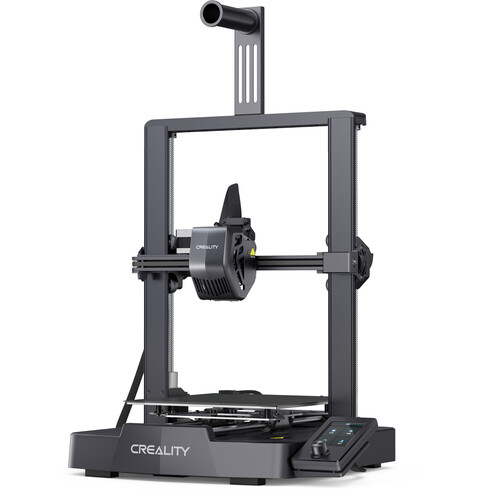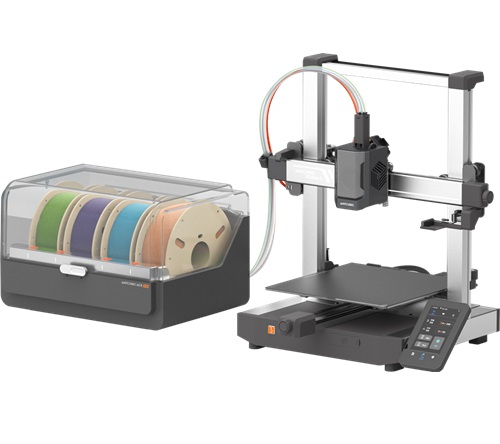Compare Ender 3 V3 SE vs Kobra 3 Combo
Comparison between the best 3D printers
Choose the best 3D printer at the best price. The cheapest 3D printers are here.
Buy a 3D printer here with 3D Fila.
 |
 |
|
| Model | Ender 3 V3 SE[BUY Ender 3 V3 SE] |
Kobra 3 Combo[BUY Kobra 3 Combo] |
| Printing Material | Filament | Filament |
| Buy Filament for Creality Ender 3 V3 SE | Buy Filament forAnycubic Kobra 3 Combo | |
| Estimated price | $199,00 | $349,00 |
| Manufacturer | Creality | Anycubic |
| Release Year | 2023 | 2024 |
| Print Volume [mm] | 220x220x250 | 250x250x260 |
| Printer Size [mm] | 420x366x490 | 452x504x483 |
| Weight [kg] | 7,34 | 9,2 |
| Power Loss Recovery | NO | YES |
| Enclosed printer | NO | NO |
| Bed Leveling | Automatic | Automatic |
| Filament End Sensor | NO | YES |
| Bed type | Heated | Heated |
| Power supply system | Direct Drive | Direct Drive |
| Standard nozzle | 0,4 | 0,4 |
| Maximum Nozzle Temperature [°C] | 260 | 300 |
| Maximum Bed Temperature [°C] | 100 | 110 |
| Maximum printing speed [mm/s] | 250 | 600 |
| Filament holder | YES | YES |
| Camera for supervision | NO | NO |
| Recommended filaments | PLA, PETG e TPU (95A+) | PLA, PETG, ABS, PP, HIPS |
| Recommended slicers | Creality Print, Cura 5.0 ou superior, Prusa Slicer, Orca | Anycubic Slicer, Cura, Orca Slicer |
| Maximum Resolution [mm] | 0,1 | 0,1 |
| Processor | 32-bit Silenciosa | 32 bits |
| Display | 3,2'' + Knob | Touchscreen 4,3'' |
| Power Supply | 350 W | 400 W |
| Connectivity | SD | USB, Wi-Fi, Cloud |
| Operating systems | Windows, Linux, Macbook | Windows, Linux, Macbook |
| Date of registration in the system | 2024-03-06 | 2024-06-27 |
| Release date | 2023 | 2024 |
| Extra features | The Ender 3 V3 SE stands out for its easy assembly, excellent automatic bed leveling, direct extrusion and easy interface, ideal for beginners. Although it uses a coated PC board, it offers robust performance, with print speeds of up to 250mm/s, thanks to a solid construction and linear rods on the Y axis. It lacks Wi-Fi, preferring file transfer via SD card. | The Anycubic Kobra 3 Combo offers advanced features, including multi-filament printing with the ACE (Anycubic Color Engine) system, allowing for quick switching of up to four filaments. It features automatic bed leveling, nozzle clogging detection, and integrated filament drying during printing. The printer supports technical materials such as ABS, ASA, Nylon, and PC, thanks to the hotend that reaches 300°C and the heated bed up to 110°C. In addition, it has a 4.3-inch touchscreen and compatibility with various slicers such as Anycubic Slicer, Cura, and Orca Slicer. |
| Support for multiple colors and materials (AMS and CFS) | NO | YES |
Notes * |
||
| Cost-benefit | 7 / 10 | 8 / 10 |
| Hardware | 0.8 / 10 | 4.5 / 10 |
| Tela | . | . |
| Print volume | 3 / 10 | 4 / 10 |
| Performance | 2 / 10 | 5 / 10 |
| [BUY Ender 3 V3 SE] | [BUY Kobra 3 Combo] |
Conclusion |
| In concluding the comparison between the Creality Ender 3 V3 SE and the Anycubic Kobra 3 Combo 3D printers, several factors highlight their respective strengths and weaknesses, making them suited for different user needs. The Ender 3 V3 SE, with its lower price point, offers a solid choice for beginners. It excels in easy assembly and robust performance with a commendable print speed of up to 250mm/s, making it an attractive entry-level option. While it lacks some advanced features like power loss recovery and filament end sensors, it compensates with a straightforward, user-friendly experience, ideal for novice users. On the other hand, the Anycubic Kobra 3 Combo, although more expensive, presents a host of advanced functionalities that cater to more experienced users or those requiring versatility in their printing projects. With enhanced capabilities such as automatic bed leveling, support for a wider range of materials, and features like nozzle clogging detection and integrated filament drying, the Kobra 3 Combo is well-equipped for intricate and varied tasks. Its higher print volume, maximum nozzle and bed temperatures, and advanced connectivity options further position it as a robust machine suitable for diverse applications. In terms of overall value, the Ender 3 V3 SE provides a commendable cost-benefit ratio for casual users, while the Kobra 3 Combo, with its extensive feature set, justifies its higher price point for those needing improved performance and flexibility. Ultimately, the choice between these two models should be guided by the user’s experience level and specific printing needs. |

